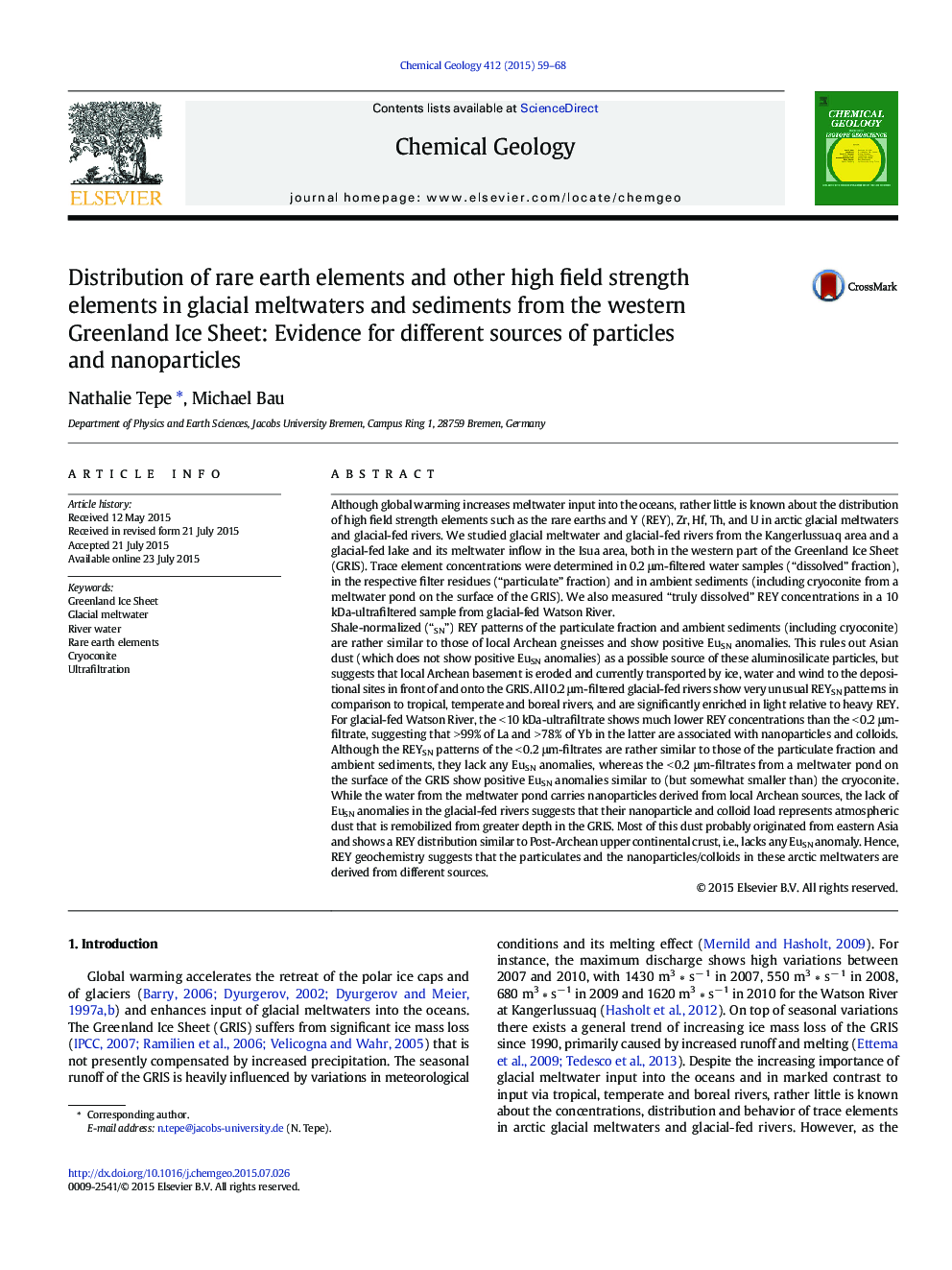| کد مقاله | کد نشریه | سال انتشار | مقاله انگلیسی | نسخه تمام متن |
|---|---|---|---|---|
| 4698422 | 1637562 | 2015 | 10 صفحه PDF | دانلود رایگان |
• Rare earths + Y, Zr, Hf, Th and U were studied in meltwaters and glacial-fed rivers.
• REY distribution and ultrafiltration show these elements to be bound to nanoparticles/colloids.
• Very low truly dissolved (< 10 kDa) concentrations of these elements in arctic rivers.
• Archean basement is a source of cryoconite, river particulates and sediments.
• Asian dust is a source of nanoparticles/colloids in glacial-fed rivers.
Although global warming increases meltwater input into the oceans, rather little is known about the distribution of high field strength elements such as the rare earths and Y (REY), Zr, Hf, Th, and U in arctic glacial meltwaters and glacial-fed rivers. We studied glacial meltwater and glacial-fed rivers from the Kangerlussuaq area and a glacial-fed lake and its meltwater inflow in the Isua area, both in the western part of the Greenland Ice Sheet (GRIS). Trace element concentrations were determined in 0.2 μm-filtered water samples (“dissolved” fraction), in the respective filter residues (“particulate” fraction) and in ambient sediments (including cryoconite from a meltwater pond on the surface of the GRIS). We also measured “truly dissolved” REY concentrations in a 10 kDa-ultrafiltered sample from glacial-fed Watson River.Shale-normalized (“SN”) REY patterns of the particulate fraction and ambient sediments (including cryoconite) are rather similar to those of local Archean gneisses and show positive EuSN anomalies. This rules out Asian dust (which does not show positive EuSN anomalies) as a possible source of these aluminosilicate particles, but suggests that local Archean basement is eroded and currently transported by ice, water and wind to the depositional sites in front of and onto the GRIS. All 0.2 μm-filtered glacial-fed rivers show very unusual REYSN patterns in comparison to tropical, temperate and boreal rivers, and are significantly enriched in light relative to heavy REY. For glacial-fed Watson River, the < 10 kDa-ultrafiltrate shows much lower REY concentrations than the < 0.2 μm-filtrate, suggesting that > 99% of La and > 78% of Yb in the latter are associated with nanoparticles and colloids. Although the REYSN patterns of the < 0.2 μm-filtrates are rather similar to those of the particulate fraction and ambient sediments, they lack any EuSN anomalies, whereas the < 0.2 μm-filtrates from a meltwater pond on the surface of the GRIS show positive EuSN anomalies similar to (but somewhat smaller than) the cryoconite. While the water from the meltwater pond carries nanoparticles derived from local Archean sources, the lack of EuSN anomalies in the glacial-fed rivers suggests that their nanoparticle and colloid load represents atmospheric dust that is remobilized from greater depth in the GRIS. Most of this dust probably originated from eastern Asia and shows a REY distribution similar to Post-Archean upper continental crust, i.e., lacks any EuSN anomaly. Hence, REY geochemistry suggests that the particulates and the nanoparticles/colloids in these arctic meltwaters are derived from different sources.
Journal: Chemical Geology - Volume 412, 27 September 2015, Pages 59–68
